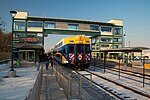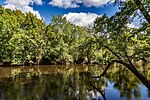Champlin Park High School
Champlin Park High School is a four-year public high school in Champlin, Minnesota, United States. The school's name comes from the combination of Brooklyn Park and Champlin. Champlin Park's first graduating class was in 1993. CPHS is the third-largest high school in the state, with a student population of 2975.Champlin Park serves the cities of Champlin, Brooklyn Park, Brooklyn Center and Dayton. In the spring of 2006, Champlin Park was certified to teach the International Baccalaureate Diploma Program. The school principal is Michael George.In 2012, 2013 and 2014, Champlin Park High School received recognition as a “Newsweek Top School,” a distinction recognizing the top high schools across the country.The school runs on a five-period, trimester curriculum.
Excerpt from the Wikipedia article Champlin Park High School (License: CC BY-SA 3.0, Authors).Champlin Park High School
Douglas Drive North,
Geographical coordinates (GPS) Address External links Nearby Places Show on map
Geographical coordinates (GPS)
| Latitude | Longitude |
|---|---|
| N 45.1501415 ° | E -93.354898 ° |
Address
Champlin Park High School
Douglas Drive North
55433
Minnesota, United States
Open on Google Maps








